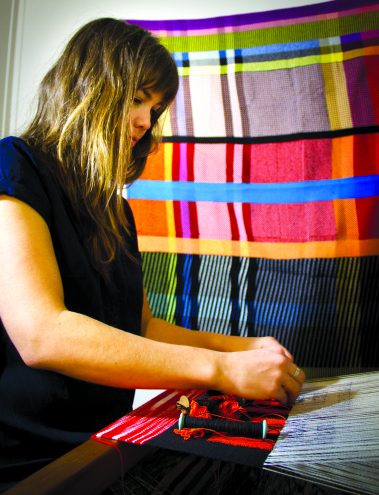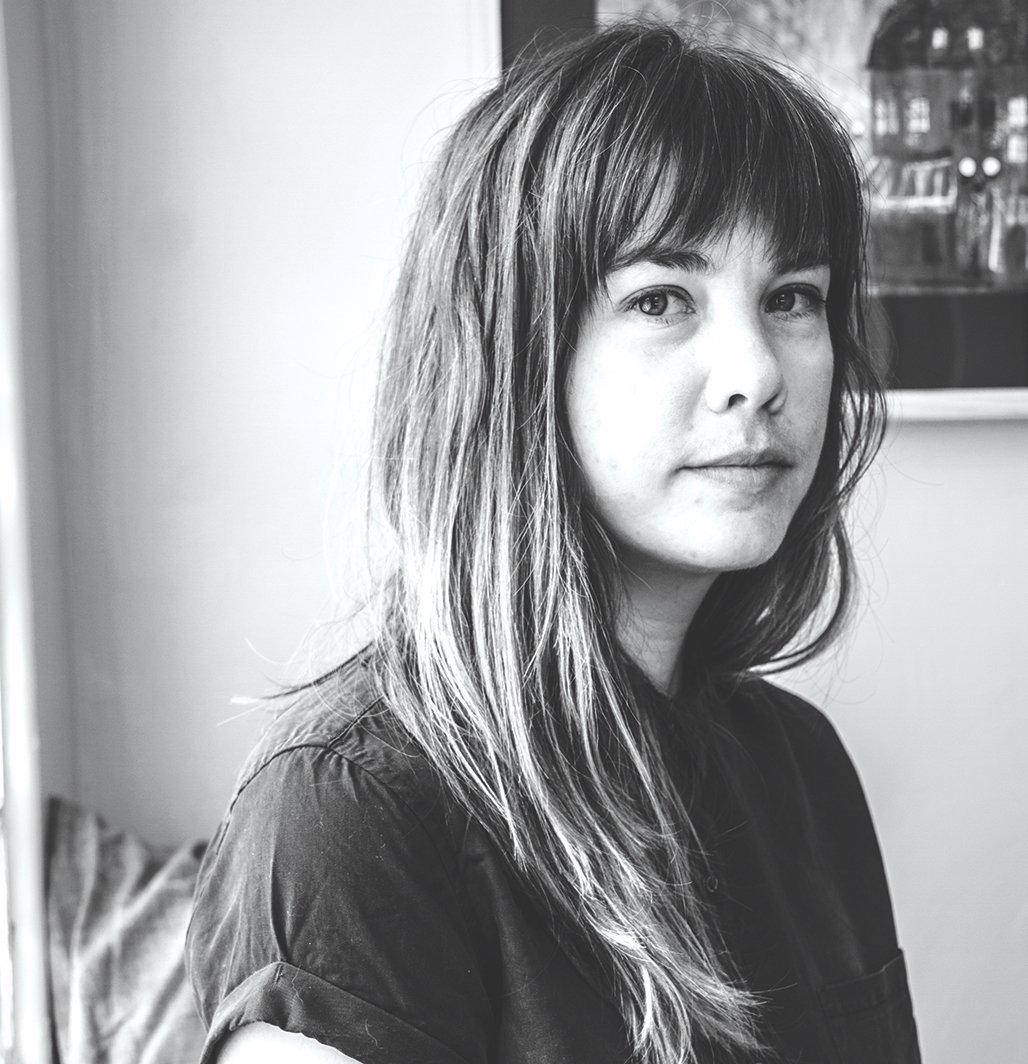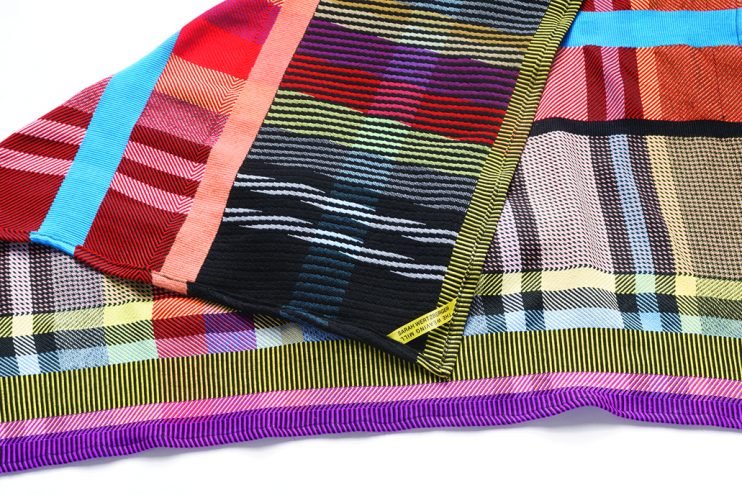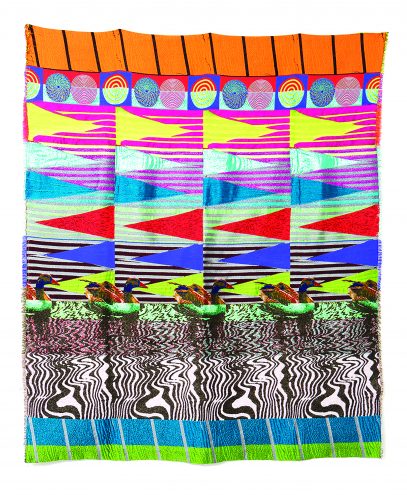Sarah Wertzberg

Invented by a man named Joseph Marie Jacquard as far back as 1804, the Jacquard weaving process is perhaps the most important weaving invention. This process made way for the automatic production of unlimited varieties of complex patterns in weaving. Utilizing this very process in her textile work, Sarah Wertzberger is able to make the paintings she has made into beautiful decorative blankets. As a multidisciplinary Portland artist and designer, Wertzberger is also very talented in making a variety of ceramic wares available for viewing on her website. A woman who wears many artistic hats, her work will be featured this fall in RISD Museum’s 21st century collection.
Eleven: How does where you are from/how you grew up inform the art you make?
Sarah Wertzberger: I grew up in the college town Lawrence, Kansas in 1980’s suburbia. Growing up in that suburban lifestyle fueled a sense of separation from meaningful connections to food, nature, objects that surround us and people. Now I try to integrate my experience of life by understanding things around me more intimately, like how knowing where things come from and how they are made. Designing and making my own things like ceramics and cloth has a DIY feel that is empowering and connective.
11: Why did you choose to create 3D art like textiles and ceramics vs painting on canvas?
SW: I majored in painting as an undergrad because I wanted to be an “artist” and I thought this was the way to do it. I thought that I had to paint or sculpt to be a “fine artist” and that the other things like textiles or ceramics were not as serious. I lived in New York after school in 2003 for five years, trying to work, paint and be a part of an art scene. My experience felt disjointed, like I didn’t fit in, and gradually living there made less and less sense. In 2008, I moved back to Lawrence, Kansas and stopped making art and felt lost. My heart was broken, but more open. Because of that, I could open myself to other possibilities of how to live. That was when the idea of what art is, or what being an artist is fell away and I became more myself. I just tried to learn new things, like how to grow food and cook better, basically to increase my quality of life. I had done some weaving in undergrad and really enjoyed it, but the school I went to viewed weaving as “craft,” which was kind of a bad word there at the time, so I didn’t feel comfortable with my interest in it. Anyhow, ten years after undergrad I got the idea to go back to graduate school to explore weaving further. Textiles was a back door, an approachable entry into making again. It has an under the radar feeling that’s both feminine and subversive, and that’s where I wanted to be. Ceramics are also something I really enjoy making. Working in clay is very different from textiles. Clay can almost be as immediate as drawing, it’s a nice foil for the long set-up process on the loom that is required for most weaving.
 11: With a degree in both textiles and painting, does one influence your work more than the other?
11: With a degree in both textiles and painting, does one influence your work more than the other?
SW: It’s a back and forth. Painting laid the foundation for my sense of color. Sometimes I might paint something to be incorporated into a weaving using the Jacquard loom. Lately weave structures and color combinations have served as the basis for my woven designs.
11: Considering the variety of mediums you work with, do you identify most with any particular label or type of artist? What type of artist would you call yourself?
SW: Mostly I try to avoid labels, because for me, they create a level of self-doubt that is a hindrance to my creative process. However, at a basic level I would say that I am an artist/designer who is driven by process. I enjoy applying my spontaneous and intuitive creative approach to new machinery, techniques and materials. In this way, making is a process of play and discovery. It’s all about having fun.
11: Is that the type of artist you envisioned you would become when you first became interested in being an artist?
SW: I remember wanting to be an artist from the time I was probably 7 or 8 years old. When I was in high school I imagined being an outcast/lone genius type of artist, or whatever my idea of what an artist was supposed to be. For some reason I identified with the post-impressionist painter Toulouse-Lautrec, who partied, played dress up with friends, made art and had a bone disease that made him really short. Now that I have matured (hopefully), I would prefer that my concept and ideas of art and design be more integrated into everyone’s everyday lives and the individual artist not be put onto a pedestal (pun intended). Maybe that is why I have been drawn to making objects that are useful. I am not trying to be simplistic but, I just do what I feel compelled to do and try not to worry too much about where it fits in or who I am as an artist. I feel like if you follow what you are interested in, there will be a place for it somewhere.
11: Do you have a favorite product that you make?
SW: I am always interested in new methods and forms of making things, and have enjoyed making ceramic cups because it is a form I keep coming back to. I enjoy making them over and over because I feel like I can’t quite figure it out, so it maintains my interest. There is just so much to learn about ceramics that it seems endless.
11: When designing each product, like your ceramics and blankets, what goes into envisioning each piece? Do you usually consider the functionality of what it would be used for or is it meant to be more of an art piece?
SW: My work falls somewhere between art and design. For the blankets and ceramics, I definitely consider their functional qualities. Weight, texture, size and handle are important to the user’s experience of the mugs. For the blankets, I consider the hand feel and ability to be washed and handled as part of its functionality as a blanket. I also think of the blankets as an art project. I approached The Weaving Mill with an interest in applying my intuitive and fluid creative approach to the structured processes of weaving on industrial looms. Over the course of nine months, I went to Chicago several times for sample weaving sessions. My intention was to use bold and playful color combinations paired with graphic weave structures to create optical vibrations that conveyed a sense of energy and joy. These open-ended weaving sessions resulted in a series of structure, color, and material samples that laid the foundation for the composition of the final blankets. The project began with the premise that TWM would push the limitations of the industrial loom in whatever way the fabrics called for to bring the spontaneity and intuitive nature of my process into the mill context in a new way.
11: A lot of the work you make requires special tools and machinery, do you work out of a personal studio or share a space?
SW: I go where the machinery is when I can, but also have a loom and studio at home. I enjoy shared spaces because they can have a supportive community feel. When I collaborated with “The Weaving Mill” in Chicago to make the blankets, I flew there multiple times to get the work done, and that was part of the fun. I also work in a shared ceramics studio called Hey Ceramics Studio in Portland. They have wheels, kilns and workspace, so it’s nice not to have to buy all the equipment when you can share instead.
11: How does color play into the pieces you make? Do you have a favorite color scheme?
SW: Color is super important to me. I start with large color palettes and don’t really define how a piece will be colored until I am weaving it. Even when I am making larger pieces, I am still in a state of play. That way, I can respond to color proportions and combinations as I am making the piece. I leave allowance for spontaneity in the process because that is what is fun to me.
11: What is your Jacquard woven collection?
SW: On a Jacquard loom, each warp string (the vertical threads of the weaving) have the ability to lift independently from the other warp threads, making for the widest range of patterning available on any loom. Essentially, you could make a weaving that looks like a photo, it can be that detailed. I used RISD’s jacquard loom to weave my designs that were based on my paintings and collages.
11: How do you juggle making personal art, working for Nike and teaching?
SW: It’s really hard to find the right balance, but I am making it work for now. I can’t do it all, but I am trying, haha. During the Fall I was collaborating with The Weaving Mill, then in the Spring I was teaching at OCAC. Having an income independent of my art enables me to be more free in the creation of my personal work, but at the same time, finding time to make the work is the hardest part. Sometimes I struggle with feeling guilty, crazy, and/or selfish for having the need to make personal work, but luckily I have a partner that has been really supportive. I recently went to an artist residency for two weeks in Maine called Haystack. Short term artist residencies are a great way to focus on personal work, while still maintaining a day job.
11: What are you working on now?
SW: I am working on finishing a woven piece I started at Haystack. I wove it in panels and have one more panel to weave. I am not sure what it will be yet.
11: Do you have any events coming up where people can see your work?
SW: My blanket collaboration with The Weaving Mill will be on view in the RISD Museum’s 21st century collection this Fall. If you are in Providence go check it out!






